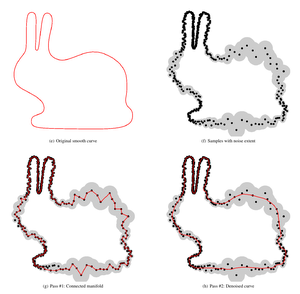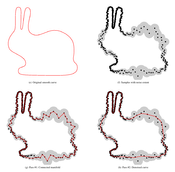Information
- Publication Type: Conference Paper
- Workgroup(s)/Project(s):
- Date: August 2018
- ISBN: 978-3-03868-073-4
- Location: Hong Kong
- Lecturer: Stefan Ohrhallinger
- Event: Pacific Graphics 2018
- Editor: H. Fu, A. Ghosh, and J. Kopf (Guest Editors)
- Booktitle: Proceedings of Pacific Graphics 2018
- Conference date: 8. October 2018 – 11. October 2018
- Pages: 1 – 4
- Keywords: Denoising, Curve reconstruction, Optimization
Abstract
We reconstruct a closed denoised curve from an unstructured and highly noisy 2D point cloud. Our proposed method uses a two-pass approach: Previously recovered manifold connectivity is used for ordering noisy samples along this manifold and express these as residuals in order to enable parametric denoising. This separates recovering low-frequency features from denoising high frequencies, which avoids over-smoothing. The noise probability density functions (PDFs) at samples are either taken from sensor noise models or from estimates of the connectivity recovered in the first pass. The output curve balances the signed distances (inside/outside) to the samples. Additionally, the angles between edges of the polygon representing the connectivity become minimized in the least-square sense. The movement of the polygon's vertices is restricted to their noise extent, i.e., a cut-off distance corresponding to a maximum variance of the PDFs. We approximate the resulting optimization model, which consists of higher-order functions, by a linear model with good correspondence. Our algorithm is parameter-free and operates fast on the local neighborhoods determined by the connectivity. %We augment a least-squares solver constrained by a linear system to also handle bounds. This enables us to guarantee stochastic error bounds for sampled curves corrupted by noise, e.g., silhouettes from sensed data, and we improve on the reconstruction error from ground truth. Source code is available online. An extended version is available at: https://arxiv.org/abs/1808.07778Additional Files and Images
Weblinks
- Extended version
- source
source code on github
BibTeX
@inproceedings{ohrhallinger_stefan-2018-pg,
title = "StretchDenoise: Parametric Curve Reconstruction with
Guarantees by Separating Connectivity from Residual
Uncertainty of Samples",
author = "Stefan Ohrhallinger and Michael Wimmer",
year = "2018",
abstract = "We reconstruct a closed denoised curve from an unstructured
and highly noisy 2D point cloud. Our proposed method uses a
two-pass approach: Previously recovered manifold
connectivity is used for ordering noisy samples along this
manifold and express these as residuals in order to enable
parametric denoising. This separates recovering
low-frequency features from denoising high frequencies,
which avoids over-smoothing. The noise probability density
functions (PDFs) at samples are either taken from sensor
noise models or from estimates of the connectivity recovered
in the first pass. The output curve balances the signed
distances (inside/outside) to the samples. Additionally, the
angles between edges of the polygon representing the
connectivity become minimized in the least-square sense. The
movement of the polygon's vertices is restricted to their
noise extent, i.e., a cut-off distance corresponding to a
maximum variance of the PDFs. We approximate the resulting
optimization model, which consists of higher-order
functions, by a linear model with good correspondence. Our
algorithm is parameter-free and operates fast on the local
neighborhoods determined by the connectivity. %We augment a
least-squares solver constrained by a linear system to also
handle bounds. This enables us to guarantee stochastic error
bounds for sampled curves corrupted by noise, e.g.,
silhouettes from sensed data, and we improve on the
reconstruction error from ground truth. Source code is
available online. An extended version is available at:
https://arxiv.org/abs/1808.07778",
month = aug,
isbn = "978-3-03868-073-4",
location = "Hong Kong",
event = "Pacific Graphics 2018",
editor = "H. Fu, A. Ghosh, and J. Kopf (Guest Editors)",
booktitle = "Proceedings of Pacific Graphics 2018",
pages = "1--4",
keywords = "Denoising, Curve reconstruction, Optimization",
URL = "https://www.cg.tuwien.ac.at/research/publications/2018/ohrhallinger_stefan-2018-pg/",
}


 image
image paper
paper
